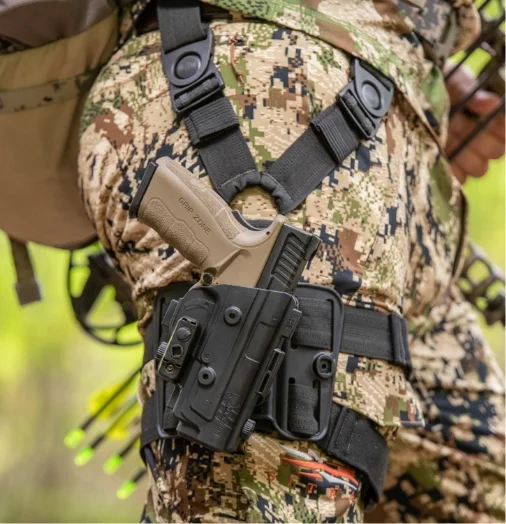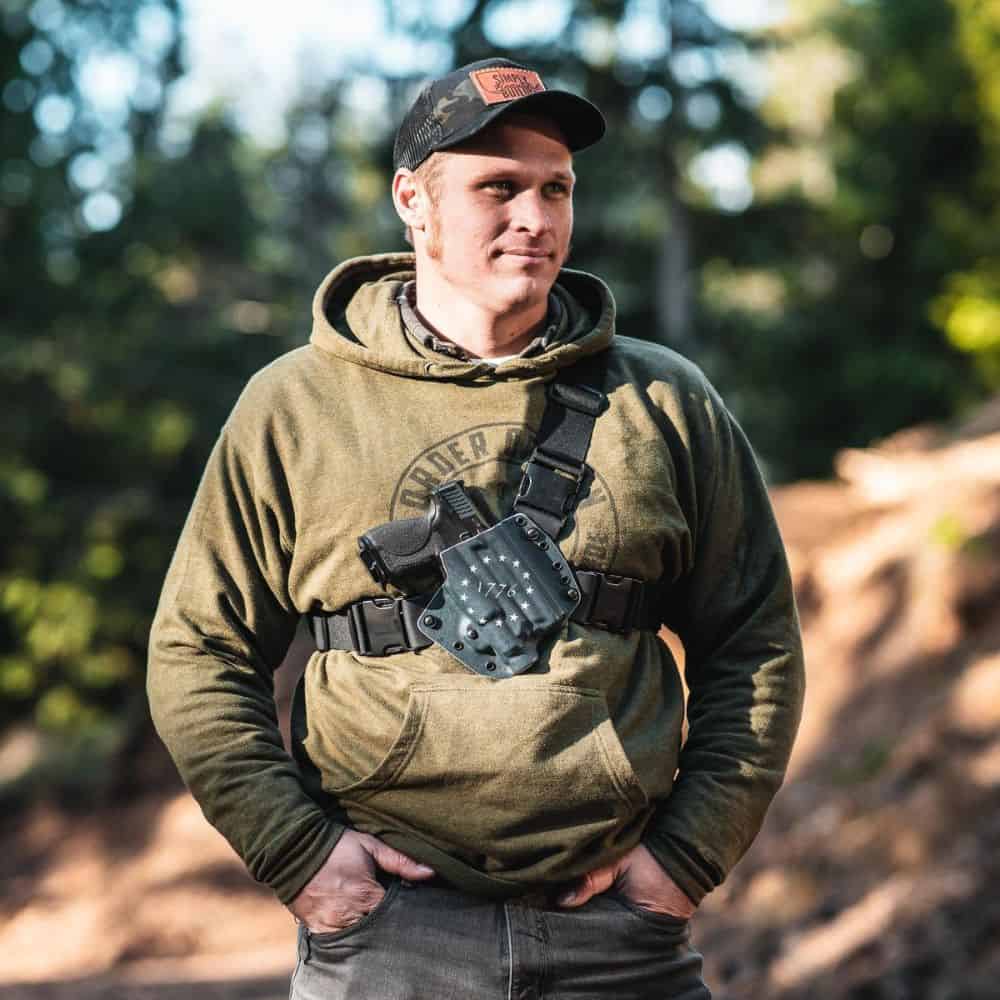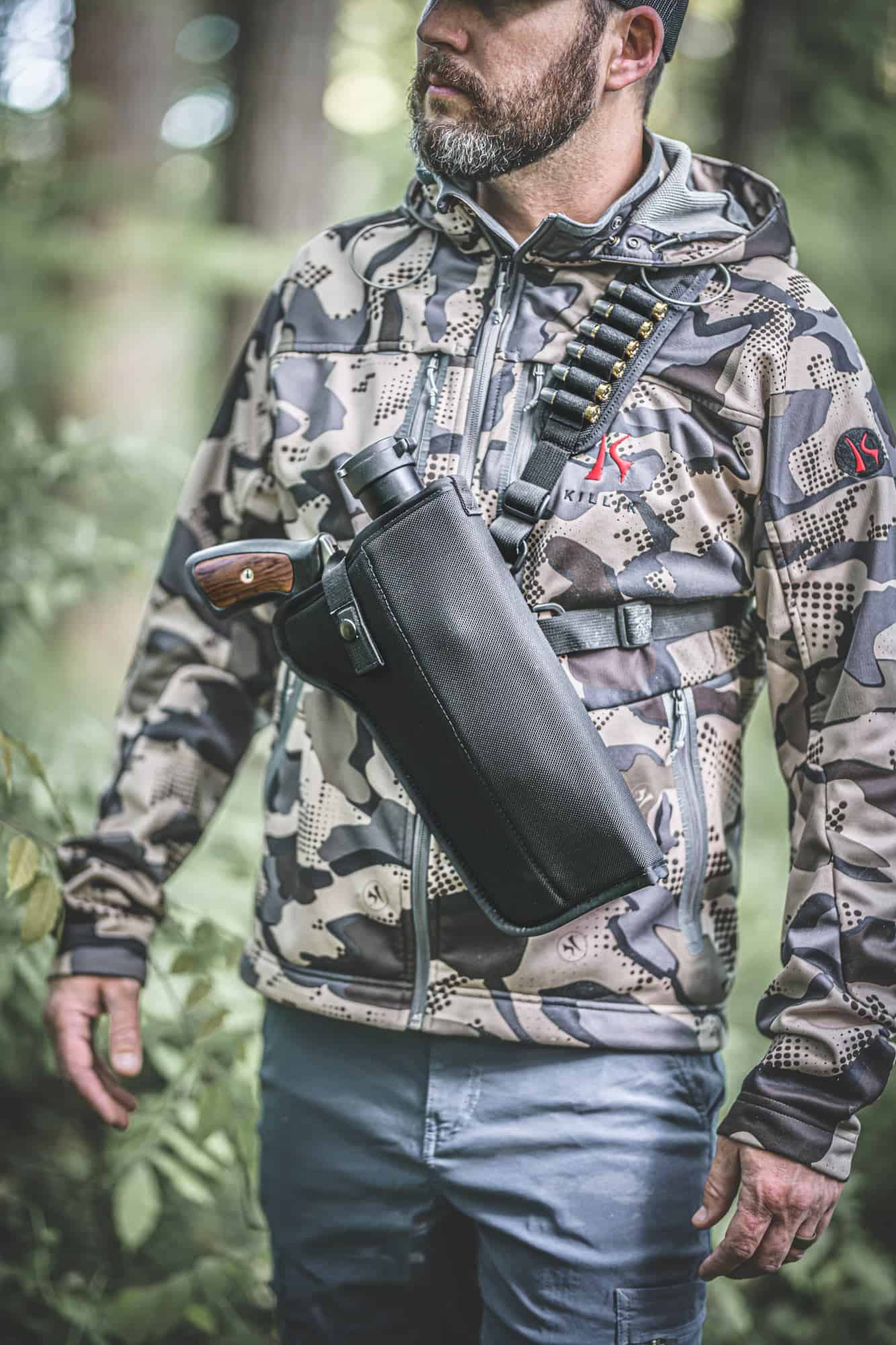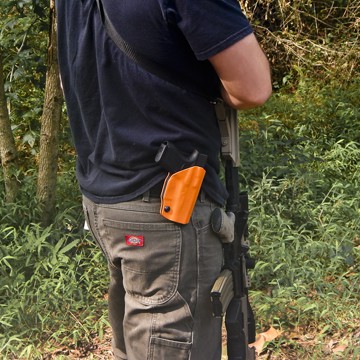Contents
- 1. Types of holsters for hunting: A comprehensive guide
- 2. Choosing the right holster for your hunting needs
- 3. Key factors to consider when selecting a hunting holster
- 4. Top features to look for in a hunting holster
- 5. Holster materials: Which is best for hunting?
- 6. Understanding holster styles and their suitability for different hunting activities
- 7. How to properly maintain and care for your hunting holster
- 8. Frequently asked questions about holsters for hunting
- 1. What is the purpose of a holster in hunting?
- 2. Are all holsters suitable for hunting?
- 3. What materials are commonly used in hunting holsters?
- 4. Can I use my regular handgun holster for hunting?
- 5. Should I opt for an open or concealed carry holster when hunting?
- 6.What type of retention system should I look for in a hunting holster?
- 7. Can I use a shoulder holster for hunting?
- 8. Are there any specific safety considerations when using a hunting holster?
1. Types of holsters for hunting: A comprehensive guide

1.1 Waistband holsters
One of the most popular types of Holsters for Hunting is the waistband holster. These holsters are worn around the waist and provide easy access to your firearm. They are typically made from durable materials such as leather or nylon, ensuring longevity even in rugged outdoor conditions. Waistband holsters can be further categorized into inside-the-waistband (IWB) and outside-the-waistband (OWB) options, each with their own advantages and drawbacks.
1.2 Shoulder holsters
Shoulder holsters offer a different approach to carrying firearms during hunting expeditions. As the name suggests, these holsters are worn over the shoulder, allowing for comfortable carry without restricting movement or hindering access to other equipment like backpacks or binoculars. They often feature adjustable straps and additional pouches for storing extra ammunition or accessories.
1.3 Ankle holsters
Ankle holsters provide a discreet method of carrying firearms while hunting in environments where concealment is crucial, such as during bow hunting or when stalking game animals at close quarters. These slim-profiled holsters wrap securely around your ankle and can accommodate smaller handguns effectively.
1.4 Chest rigs
Chest rigs have gained popularity among hunters who prefer a hands-free approach to carrying their firearms while keeping them readily accessible at all times. These harness-like systems allow you to wear your firearm across your chest, distributing its weight evenly and providing quick access when needed.
1.5 Thigh/leg holsters
Thigh/leg holsters offer an alternative method of carry that may be more suitable for those who require unrestricted movement in rugged terrains during hunting. These holsters are strapped to the thigh or leg, providing a secure and comfortable way to carry firearms without interfering with other equipment or impeding mobility.
1.6 Holster materials
When choosing a holster for hunting, it’s essential to consider the material it is made from. Leather holsters offer durability, protection, and a classic look. Nylon holsters, on the other hand, provide lightweight options that are resistant to water and abrasion. Kydex holsters offer excellent retention and trigger guard coverage while being highly durable.
Remember that selecting the right holster type depends on various factors such as personal preference, comfort level, accessibility needs for your firearm during hunting activities, and local regulations regarding concealed carry. It’s crucial to research local laws before making your final decision.
With this comprehensive guide on different types of holsters for hunting in mind, you can make an informed choice that suits your specific needs as an outdoor enthusiast.
2. Choosing the right holster for your hunting needs

When it comes to hunting, having the right equipment is crucial for a successful and enjoyable experience. One of the most important pieces of gear you’ll need is a quality holster to securely hold your firearm while in the field. With so many options available, it can be overwhelming to choose the right one. Here are some essential features to consider when selecting a holster for your hunting needs:
1. Material
The material of the holster plays a significant role in its durability and functionality. Leather holsters are popular due to their traditional look and ability to mold perfectly around your firearm over time. They offer excellent retention and protection against scratches, but they may require more maintenance compared to other materials.
2. Retention
A good hunting holster should have proper retention mechanisms in place to keep your firearm secure during vigorous activities like hiking or climbing through rough terrains. Look for holsters with adjustable retention screws or straps that allow you to customize how tightly it holds onto your weapon.
3. Accessibility
In fast-paced hunting situations, quick access to your firearm is vital. Choose a holster that allows easy drawing and re-holstering without compromising safety measures.
4. Comfort
Hunting often requires long hours spent outdoors, so comfort should not be overlooked when choosing a holster. Look for designs with padded backings or ergonomic shapes that minimize discomfort during extended wear.
5.Protection from Elements
Nature can be unpredictable, so ensure that your chosen holster offers adequate protection against moisture, dust, and other elements that could potentially damage or affect the performance of your firearm.
Remember, finding the perfect hunting holster is a personal choice. Take the time to research different options, read reviews, and try them out before making a final decision. By considering these essential features, you can find a holster that not only meets your specific needs but also enhances your hunting experience.
3. Key factors to consider when selecting a hunting holster

1. Comfort and Fit
When it comes to selecting a hunting holster, comfort and fit should be your top priorities. Remember, you’ll be wearing the holster for long hours in various weather conditions, so it’s crucial that it feels comfortable on your body. Look for holsters with adjustable straps or belts to ensure a secure fit that can accommodate different body types.
2. Accessibility
Another important factor to consider is how easily accessible your firearm will be when using the holster. In a hunting situation, quick access to your weapon is crucial for safety reasons and seizing opportunities when they arise. Look for holsters with smooth draw mechanisms that allow you to effortlessly retrieve your firearm without fumbling or wasting precious time.
3. Retention System
A reliable retention system is essential for keeping your firearm securely in place while on the move during hunting expeditions. Consider holsters with retention mechanisms such as thumb breaks or trigger guard locks that provide an additional layer of security but also allow for quick release if needed.
4. Durability and Material
Hunting often involves rugged terrains and harsh weather conditions, so durability is paramount when choosing a hunting holster. Opt for holsters made from high-quality materials like Kydex or premium leather that can withstand wear and tear while protecting your firearm from external elements.
5. Compatibility
Ensure compatibility between the holster and your specific handgun model before making a purchase decision. Different firearms have unique shapes, sizes, trigger guards, and accessory attachments; thus, not all holsters are designed universally to accommodate every gun type adequately.
These key factors are vital considerations when selecting a hunting holster that meets both practicality and safety requirements during outdoor adventures where quick access to firearms may be necessary. By prioritizing comfort, accessibility, Retention Systems, durability, and compatibility, you can make an informed choice that enhances your hunting experience while ensuring the safety of yourself and others in the field. Happy hunting!
4. Top features to look for in a hunting holster

1. Durability and Material
When choosing a hunting holster, durability is of utmost importance. Look for holsters made from high-quality materials such as nylon, leather, or Kydex. These materials offer excellent resistance to wear and tear, ensuring your holster will last through rugged outdoor conditions.
2. Retention System
A reliable retention system is crucial in a hunting holster to securely hold your firearm in place while you navigate through challenging terrains. Opt for holsters with adjustable retention mechanisms like thumb breaks or trigger guards that ensure quick and easy access while keeping the firearm securely holstered.
3. Comfort and Fit
Comfort is key when it comes to wearing a hunting holster for long periods of time during outdoor activities. Look for holsters with padded interiors or adjustable straps that provide maximum comfort and prevent discomfort or chafing. Additionally, choose a holster that fits your specific firearm model snugly to avoid any unnecessary movement.
4. Accessibility
Quick access to your firearm can be critical in hunting situations where timing is everything. Consider holsters with quick-draw designs that allow you to effortlessly retrieve your weapon when needed without fumbling or delays.
5. Water Resistance
Outdoor environments are often unpredictable, so it’s essential to choose a hunting holster that offers water resistance properties. This feature ensures the protection of your firearm from moisture damage caused by rain, splashes, or sweat.
6. Versatility
Look for holsters that offer versatility in terms of carry options such as belt loops, paddle attachments, or MOLLE compatibility systems so you can adapt them according to your preference and the demands of different hunting scenarios.
7.Camouflage
For hunters, blending into the natural surroundings is crucial to avoid spooking game. Consider holsters with camouflage patterns or colors that match your hunting gear and environment, providing you with an extra advantage in remaining undetected.
8. Retention and Accessibility Balance
Finding a holster that strikes the right balance between retention and accessibility is essential. You want your firearm to be secure but easily accessible when needed without compromising safety or comfort.
By considering these top features when selecting a hunting holster, you can ensure that your firearm remains safe, secure, and conveniently accessible during all your outdoor adventures. Remember to prioritize durability, comfort, accessibility, water resistance, versatility, and retention system reliability for a well-rounded hunting holster that meets all your needs as an outdoor enthusiast.
5. Holster materials: Which is best for hunting?
When it comes to choosing the right holster for hunting, one of the key factors to consider is the material it is made of. Different materials offer unique benefits and drawbacks, so it’s essential to understand which one suits your needs best.
Nylon holsters
Nylon holsters are a popular choice among hunters due to their affordability and durability. They are lightweight and resistant to wear and tear, making them ideal for outdoor activities. Nylon holsters also provide good protection against moisture, which is crucial when venturing into wet or humid environments.
However, nylon may not be as rigid as other materials, so it might lack the necessary retention needed in certain situations. Additionally, continuous exposure to sunlight can cause nylon holsters to fade or deteriorate over time.
Leather holsters
Leather has long been recognized as a classic holster material due to its timeless appeal and exceptional durability. Leather holsters offer excellent retention capabilities while providing a snug fit for your firearm. They are designed with precision stitching that enhances their strength and longevity.
Moreover, leather molds itself over time according to your specific firearm, ensuring a custom fit that improves draw speed and ease of use. However, leather holsters require regular maintenance such as cleaning and conditioning to prevent dryness or cracking caused by exposure to harsh elements.
Kydex holsters
Kydex is a thermoplastic material widely used in modern holster manufacturing due to its superior strength and versatility. It offers excellent impact resistance while maintaining its shape even under extreme conditions. Kydex holsters are known for providing secure retention without sacrificing quick draw speed.
Additionally, Kydex does not absorb moisture like other materials do; thus preventing rusting or damage caused by prolonged exposure in wet environments. However, some users find Kydex holsters to be less comfortable against the skin due to their rigid nature.
Hybrid holsters
Hybrid holsters combine different materials, usually leather and Kydex or nylon and Kydex, to offer a balance between comfort and functionality. These holsters often feature a leather backing for enhanced comfort against the body, while the Kydex shell provides excellent retention and protection for your firearm.
The hybrid design allows for better weight distribution, reducing fatigue during long hunting trips. However, hybrid holsters tend to be bulkier compared to other options due to their layered construction.
In conclusion, selecting the right holster material is crucial when it comes to hunting. Nylon offers affordability and durability but may lack retention in some cases. Leather provides timeless appeal and custom fit but requires regular maintenance. Kydex combines strength with quick draw capability but might be less comfortable against the skin. Hybrid holsters aim for a balance of comfort and functionality by combining different materials. Consider your specific needs as well as personal preferences when making your decision.
6. Understanding holster styles and their suitability for different hunting activities
When it comes to hunting, having the right holster can make all the difference in terms of convenience, accessibility, and safety. With a wide range of holsters available on the market, it’s important to understand the various styles and their suitability for different hunting activities.
1. Waistband Holsters
Waistband holsters are one of the most popular choices among hunters due to their versatility and easy access. These holsters are typically worn around the waist and can be positioned either inside or outside the pants. They provide quick drawing capabilities while keeping your firearm secure during rigorous outdoor activities.
2. Shoulder Holsters
If you prefer a more concealed carry option that allows for better weight distribution, shoulder holsters might be ideal for you. These holsters are worn over the shoulders with straps crossing your chest, providing easy access to your firearm without hindering movement or causing discomfort during long hunting trips.
3. Thigh Holsters
Specially designed for those who prefer a lower carry position, thigh holsters offer excellent accessibility while keeping your weapon out of sight when needed. These holsters attach securely to your thigh using adjustable straps or elastic bands, making them suitable for hunters who need quick draw capabilities without compromising mobility.
4. Chest Holsters
Chest holsters are an excellent choice when you require easy access to your firearm while keeping it within sight at all times. Typically worn across the chest like a harness, these holters offer superb weight distribution and comfort during long hunts in rugged terrains where other types of holters may not be as practical.
5. Ankle Holster
Ankle holsters are perfect for hunters who need a discreet and easily concealable option. These holsters are worn around the ankle, allowing you to carry a smaller firearm or backup weapon comfortably. While ankle holsters may not offer the fastest access, they provide an additional layer of protection in situations where carrying on your waist or chest is not feasible.
6. Belt Holsters
Belt holsters are considered a classic choice for hunters due to their simplicity and reliability. These holters attach securely to your belt, providing easy access to your firearm while keeping it snug against your body. Belt holters can be worn on either side of the hip depending on your dominant hand, making them suitable for both right-handed and left-handed hunters.
Understanding the different holster styles available and their suitability for different hunting activities is crucial when choosing the right holster for yourself. Consider factors such as comfort, accessibility, concealability, and personal preference before making a decision that will enhance your overall hunting experience.
7. How to properly maintain and care for your hunting holster
Clean Your Holster Regularly
To ensure the longevity of your hunting holster, it is crucial to clean it regularly. After every hunting trip, wipe down the holster with a damp cloth to remove any dirt or debris that may have accumulated. For stubborn stains, use a mild soap solution and gently scrub the affected area. Avoid using harsh chemicals or abrasive materials as they can damage the holster’s material.
Keep It Dry
Moisture can be detrimental to your hunting holster’s integrity, so always make sure it stays dry. After cleaning, allow the holster to air dry completely before storing it away. If you’ve been hunting in wet conditions, consider using a towel or cloth to absorb any excess moisture on the surface of the holster.
Avoid Extreme Temperatures
Extreme temperatures can warp or distort your hunting holster, compromising its fit and functionality. It is best to store your holster in a cool and dry place when not in use. Avoid leaving it exposed to direct sunlight for prolonged periods as this can cause fading and weakening of the material.
Inspect for Wear and Tear
Regularly inspect your hunting holster for any signs of wear and tear such as loose stitching or cracks in the material. Addressing these issues promptly will prevent further damage and ensure that your pistol remains secure while you’re out in the field.
Proper Storage
When not using your hunting holster, store it properly to maintain its shape and condition. Consider investing in a dedicated storage case or pouch that provides protection from dust, moisture, and other potential hazards.
Remember that proper maintenance extends beyond just caring for the exterior of your holsters; you should also pay attention to their internal components if applicable (e.g., retention mechanisms). Following these guidelines will help you preserve the quality and functionality of your hunting holster for years to come.
8. Frequently asked questions about holsters for hunting
1. What is the purpose of a holster in hunting?
A holster serves as a secure and accessible storage solution for hunters to keep their firearms within reach while ensuring safety during outdoor activities. It allows quick and easy access to the weapon when needed, minimizing the risk of accidents.
2. Are all holsters suitable for hunting?
No, not all holsters are designed specifically for hunting purposes. Hunting requires specific features such as camouflage patterns, durability, and noise reduction. It is essential to choose a holster that meets these requirements to blend into the environment and avoid scaring away potential game.
3. What materials are commonly used in hunting holsters?
Hunting holsters are typically made from durable materials such as leather, nylon, or Kydex. These materials provide strength, weather resistance, and protection against wear and tear in rugged outdoor conditions.
4. Can I use my regular handgun holster for hunting?
While it may be possible to use a regular handgun holster for hunting in some cases, it is generally recommended to invest in a dedicated hunting holster with specific features tailored towards outdoor activities. Regular holsters may lack important characteristics like camouflage or noise reduction.
5. Should I opt for an open or concealed carry holster when hunting?
The choice between an open or concealed carry holster depends on personal preference and local regulations concerning firearm display during hunts. Open carry provides faster access but may increase the chance of visibility by wildlife or other hunters.
6.What type of retention system should I look for in a hunting holster?
A good retention system keeps your firearm secure during movements yet allows quick draw when required without compromising safety standards.An adjustable retention mechanism like thumb breaks or tension screws can offer the ideal balance between security and accessibility.
7. Can I use a shoulder holster for hunting?
Shoulder holsters can be an option for hunting, especially if you prefer carrying your firearm across your chest or back. However, keep in mind that shoulder holsters may limit mobility and comfort during long periods of active hunting.
8. Are there any specific safety considerations when using a hunting holster?
Safety should always be a top priority when using any type of holster for hunting. Ensure that the trigger guard is fully covered to prevent accidental discharges, and practice proper firearm handling techniques at all times. It’s also crucial to follow local laws and regulations regarding firearms while engaging in outdoor activities.
Remember, choosing the right holster for your hunting needs is essential to ensure both convenience and safety throughout your outdoor adventures.

Brian Belko is a freelance writer and blogger. His primary areas of focus include the outdoors and shooting sports. In addition to his freelance work, Brian also writes for Wide Open Spaces and is on the Pro Staff at Military Hunting and Fishing. When he isn’t busy writing, Brian enjoys fishing farm ponds for bass and hitting the spring woods during turkey season.
